Retrofit Florida: Create Jobs and Save Money on Electricity from Florida Solar Energy Center on Vimeo.
What will happen to Florida if we do not pass an Energy Policy this year? What will be the cost of our monthly electric bills if we do nothing? Will we save money and create jobs if we do nothing?
Can we invest in our Energy Future without raising taxes? Let’s look to our homes to create New Clean Green Jobs for Florida so we can create economic growth, which increases the state’s revenues. Let’s renovate our homes cost-effectively, thereby saving money on our monthly electric bills. Let’s not ship money out of state for purchase of coal and natural gas to make electricity. Let’s put people to work and use some of the energy savings to put solar energy on our roofs.
Fifty-one percent of the electricity that utilities produce are used in our residences, “we the citizens” consume electricity so, “we” need to use energy efficiently.
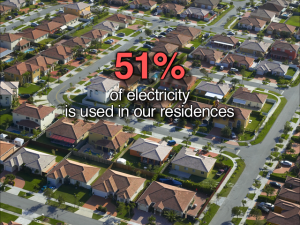
This plot shows the average annual household electricity use in MWh/yr historically, along with the October 2009 Florida Public Service Commission 10-Year Forecast.
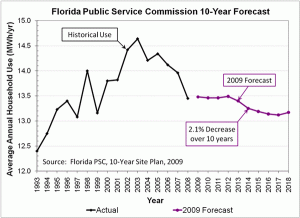
The actual energy use per household showed an increase from 1993 until the peak electricity use per household of 2003 (14.6 MWh/yr).
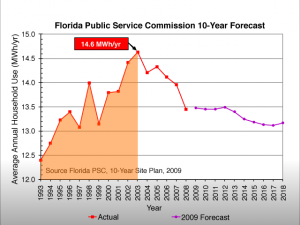
The 2009 forecast, predicted in 2008, shows a decrease of 2.1% in average annual household electricity use over the ten year forecast.
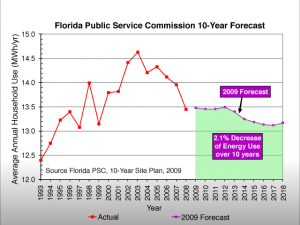
Clearly, if “we” use less electricity, it is good for the environment and it requires Florida to import less fossil fuels like natural gas and coal into Florida, but does it mean “we” pay less per month for electricity?
No, we will pay more and this plot shows why.
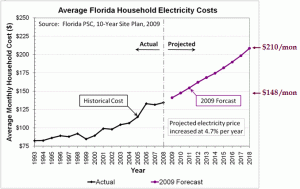
This plot of the average monthly household electricity cost over time shows the historical costs and the 10-year forecasted costs. The 2009 forecast shows a decrease in electricity consumption of 2.1% over the ten-year period of 2009 to 2018, but electricity cost is increasing at 4.7% per year, so the electric cost of ~$148 per month of today turns into $210 per month by 2018.
This means that the cost of having no new energy policy and doing business as usual will cost the citizens of Florida at least $62 per month in 2018, there will be no new job creation and we will continue to purchase more fossil fuels and export our money out of the state.
Does it have to be this way? No, we must pass an Energy Policy that provides incentives and loans to retrofit our homes to make them more energy efficient.
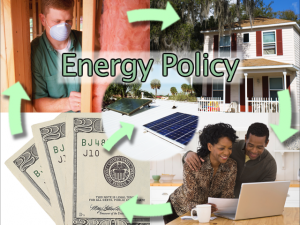
We can actually pay less for electricity each month than we do now, and use the savings to purchase the efficiency improvements and provide rebates for putting solar energy on our roofs.
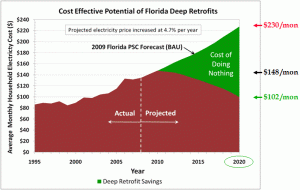
If we cost effectively retrofit our homes with eight energy efficiency measures and solar hot water heating, instead of paying $82 more each month in 2020, we will save $46 each month over today’s cost. The cost of doing nothing compared to the cost of an energy policy that encourages energy efficiency and solar energy on your rooftop is more than $128 month or $1,536 per year, per household.
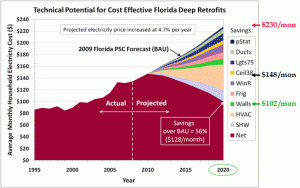
The eight energy efficiency measures and solar water heating provides energy savings of 56% ($128 per month per household).
The savings measure in the order of most economical (lowest cost to benefit ratio) are:
| Key | Efficiency Measure | Specification | Cost to Benefit Ratio |
|---|---|---|---|
| Programmable Thermostat | 2 degrees set up/back | 0.22 | |
| Attic Duct Leakage | 10% → 3% | 0.31 | |
| Fluorescent Lighting | 10% → 75% | 0.32 | |
| Upgrade Ceiling Insulation | R18 → R38 | 0.35 | |
| Windows | U-0.75 → 0.39 /SHGC-0.65 → 0.28 | 0.71 | |
| Refrigerator Replacement | ENERGYSTAR | 0.74 | |
| Exterior Block Wall Insulation | R-1 → R-10 | 0.75 | |
| Air Conditioner | SEER 9.25 → SEER 17 to 21 | 0.95 | |
| Solar Hot Water | 40 ft2, 80 gallon, PV-pumped | 0.97 |
We can do something. We should chose to retrofit our homes cost-effectively to make them more energy efficient. We will then pay less for electricity each month than we do now and use the savings to purchase the efficiency improvements and provide rebates for putting solar energy on our roofs.
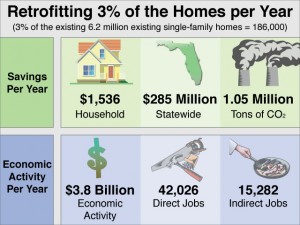
Retrofitting 3% of the homes per year will generate $1,536 in energy savings per home — a total of $285 million in total cost savings for the 186,000 retrofitted homes, while saving 1.05 million tons of CO2. Each year we will generate $3.8 billion in new economic activity, 42,026 direct jobs and 15,282 indirect jobs.
If Florida invests in our homes, people go back to work, property values increase, and we save money every month!
I market a Retro-fit product for AC units (residential & Commercial) which has documented savings of approx 20% (plus)
How do I capture the attention of FSEC ???
Please assist – Thank you
John Daly 772-579-8971
The PACE program for low cost loans for energy retro-fits was recently dealt a setback by Freddie Mac and Fannie Mae. However, there are still cost effective ways to save energy and money for your home. These measures include everything from lightbulb changes to solar hot water installation and are the best way to protect yourself from rising energy costs and dependency on unstable outside influences.
Very interesting statistics which I will find very useful, thank you. John
Has a solar heat/concentrator-ammonia chiller system been investigated for ambient high temperature & solar radiation conditions for home cooling?
Good Day! Eugene
(904) 655-0041
I must say that this site does not pass my Carl Sagan Baloney test. I realize it is sponsored by a research institute of the University of Central Florida (We call it U Can’t Finish here in Central Florida), but it comes across as propaganda for some political agenda.
The facts are true, but they are presented in a manner that distorts the meaning.
Yes, $1,536 per year can be saved by solar photovoltaic panels on single resident homes. They left out the current cost of that savings. That amount of savings requires an investment of $30,000 for each home. Ed Begley jr. has that type of system on his house, but the rest of us might be a little limited in purchasing such an efficient system. Can you get a twenty year loan with no interest to retrofit your home?
My calculator comes up with $5.58 billion needed for a total of $285 million in total cost savings per year for the 186,000 retrofitted homes used as an example in that web site. That comes to twenty years before the cost is recovered. Don’t get me wrong. It would be a great thing to have this happen. There are external savings to the environment and economic job markets to consider. My point is that Florida is close to being broke, as are many of the residents.
Smaller units are available. $10,000 gets you $500 per year savings. Twenty years to realize your cost in savings.
Let’s do a little math.
I used 61 KWH of electricity this past July because of air conditioning. It cost me $0.104 per KWH or $198.64 plus taxes and fees from my local utility.
A solar panel costs $10-12 per watt installed. A panel that costs $1,000 powers a computer or television, but not a refrigerator. It may be enough for a small R/V with one window unit sized A/C on the roof, but only when the microwave is not on or a toaster (“Solar Cost FAQ,” n.d.).
Apartment complexes save utilities by having more than one family under a single roof. The size of a panel to power one family’s needs would be larger than the roof shared by 6 families in a three story building.
reference:
Solar cost FAQ. (n.d.). The solar guide [information sheet]. Retrieved September
12, 2010, from Tsavo Media Canada Inc. website:
http://www.thesolarguide.com/solar-power-uses/cost-faq.aspx
Thanks to new regulations from the Obama administration, power companies will shut down a significant number of coal-fired plants by 2014, and without any other reliable sources of mass-produced electricity, consumers will see their bills go up as much as 60% by 2014.
zitiboat is assuming too high of an installation cost estimate on pv. Maybe years ago $10-$12 was the going rate but check in a florida solar contractor now and you’ll find $7 – $8 watt installed a much more factual picture.
While I’m a persona proponent of solar power (I’m slowly adding small scale pv panels to some of my outbuildings), a previous comment brings to light the high initial cost.
I do believe that ultimately, we will be faced with eating those costs due to an energy/resource crunch.
Lighting uses about 18 percent of the electricity generated in the U.S., and another 4 to 5 percent goes to removed the waste heat generated by those lights. Lighting in commercial buildings accounts for close to 71 percentage of overall lighting electricity used in the U.S. Lighting consumes close to 35 percentage of the electricity used in commercial buildings in the U.S. Lighting systems produce large amounts of heat as well as light. Lighting is the largest source of waste heat (HEAT GAIN) inside commercial buildings. Finally, lighting is the single largest cost component of a commercial building’s electricity bill!
WHICH IS MORE COST EFFECTIVE AND TIMELINESS? RESIDENTIAL ENERGY SAVING? RENEWABLE ENERGY? OR LIGHTING RETROFIT FOR COMMERCIAL BUILDINGS?